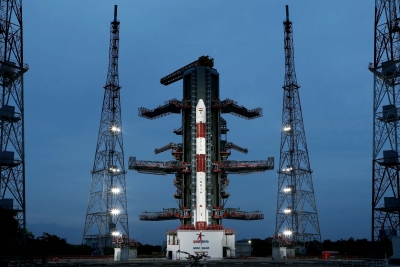By Venkatachari JagannathanSriharikota (Andhra Pradesh) Nov 26 : Indias Polar Satellite Launch Vehicle-C54 (PSLV-C54) on Saturday morning lifted off with the Indo French earth observation satellite (EOS 6) and eight nanosatellites from the rocket port here in Andhra Pradesh.
The XL variant of PSLV rocket carrying the 1,117 kg EOS-6 as its primary passenger and eight others as piggybacks- blasted off from the first launch pad at Satish Dhawan Space Centre (SDSC) here at 11.56 a.m.
The piggybacks include satellites from two Indian startups – Syzygy Space Technologies Pvt Ltd, commonly known as Pixxel (Anand-16.51 kg), and Dhruvaspace’s two Thybolt satellites – 1.45 kg, Spaceflight USA’s Astrosat (four numbers 17.92 kg) and ISRO’s INS-2B (18.28 kg).
If the launch is successful, the PSLV rocket would have launched 349 foreign satellites belonging to 36 countries since 1999 with the PSLV rocket.
The four stage expendable, 44.4 m tall XL variant of PSLV rocket weighing 321 ton slowly rose-up towards the skies with thick orange flame at its tail.
The rocket gained speed as it went up while emitting a rolling thunder sound.The PSLV rocket is powered by solid (first and third stages) and liquid (second and fourth stages) fuels alternatively.
The rocket that flew on Saturday was the 56th mission of PSLV and 24th mission using the PSLV-XL variant having six strap-on booster motors with six ton fuel.
According to ISRO, the Indo French collaborative EOS-6/Oceansat will provide continuity services of Oceansat-2 spacecraft with enhanced payload capabilities and application areas.
The EOS-6 payloads include Ocean Color Monitor (OCM-3), Sea Surface Temperature Monitor (SSTM), Ku-Band Scatterometer (SCAT-3) and ARGOS – a French payload.
According to France, ARGOS will reinforce the existing fleet of Indo-French satellites working on weather surveillance that are already in orbit (MEGHA-TROPIQUES and SARAL-ALTIKA), thus enhancing contributions related to the objectives of the Paris Agreement.
The ISRO said the satellite will ensure data continuity of ocean colour and wind vector data to sustain the operational applications.
It will also improve the applications, some additional datasets such as Sea Surface Temperature and more bands in Optical region for fluorescence and in Infrared region for atmospheric corrections are accommodated.
The satellite will also develop/improve related algorithms and data products to serve in well established application areas and to enhance the mission utility.
The INS-2B is ISRO’s second nano satellite for Bhutan with two payloads viz., NanoMx and APRS-Digipeater.
According to ISRO, NanoMx is a multispectral optical imaging payload developed by its Space Applications Centre (SAC).
The APRS-Digipeater payload is jointly developed by DITTBhutan and ISRO’s UR Rao Satellite Centre (URSC).
The Pixxel’s Anand nanosatellite is a technology demonstrator to demonstrate the capabilities and commercial applications ofminiaturized earth-observation camera for earth observation using a microsatellite in Low Earth Orbit.
This is a three-axis stabilised satellite consisting of a satbus, accommodating all subsystems like telemetry, tele-command, electrical power system, Attitude Determination and Control System (ADCS), on-board computers and others and a payload unit, ISRO said.
The Thybolt satellites from Dhuruvaspace has a communication payload to enable rapid technology demonstration and constellation development for multiple users.
It also demonstrates Store-and-Forward functionality for authorised users in the amateur frequency band.
The Thybolt satellites will be deployed by using Dhruva Space Orbital Deployer to perform the specific mission operations for a minimum lifetime of one year.
Astrocast, a 3U spacecraft, is a technology demonstrator satellite for the Internet of Things (IoT) as the payload.
The rocket will orbit the EOS-6 and the eight small satellites in two different sun synchronous polar orbits (SSPO).
About 17 minutes into the flight the rocket will first eject EOS-6.Then the orbit will be changed by using two Orbit Change Thrusters introduced in the rocket’s propulsion bay ring.
The piggyback passengers will be separated in Orbit-2.
(Venkatachari Jagannathan can be reached at v.jagannathan@ians.in)
vj/arm
#PSLV #rocket #Indo #French #satellite #nanosatellites #Telugu #TeluguStop #AndhraPradesh #Anand #Hari #Jagannathan #Kota #Kota #Paris #Axis #ISRO
.






